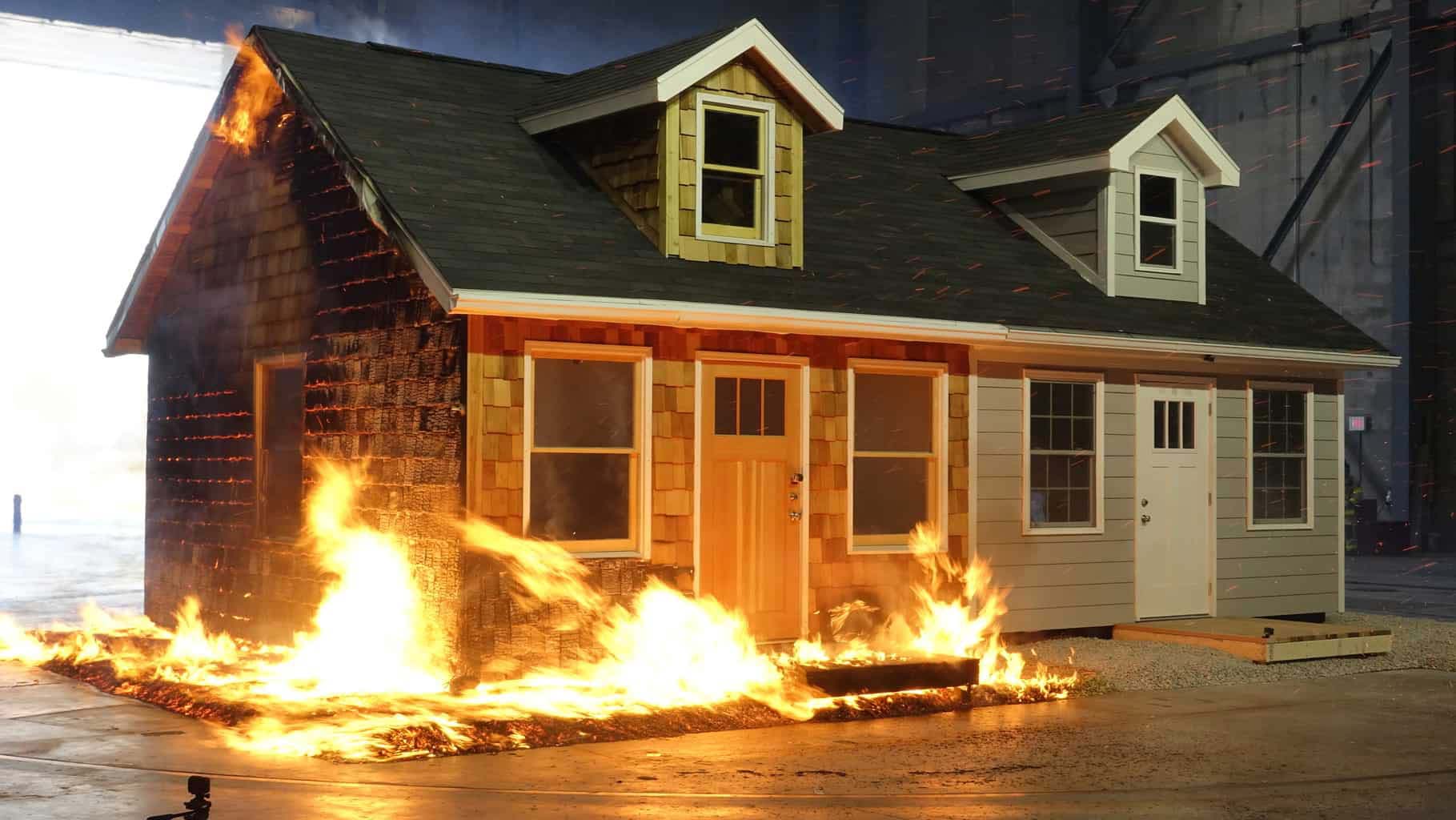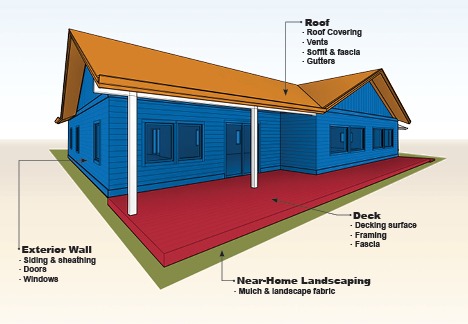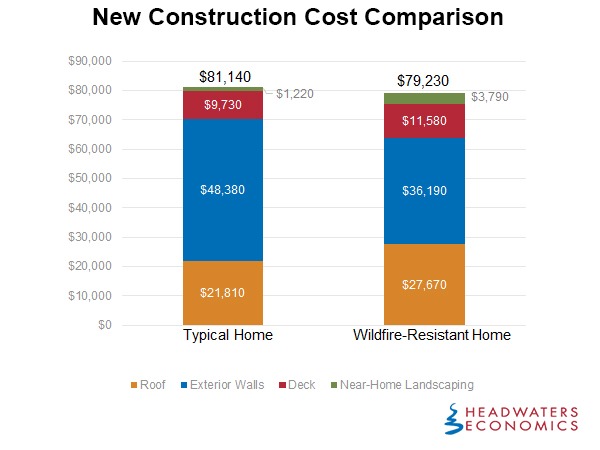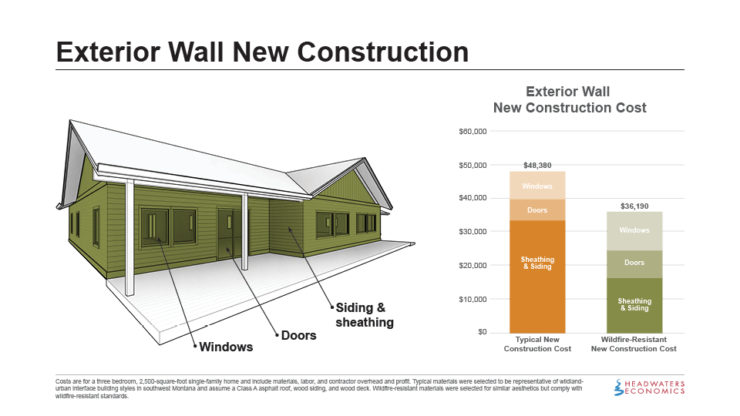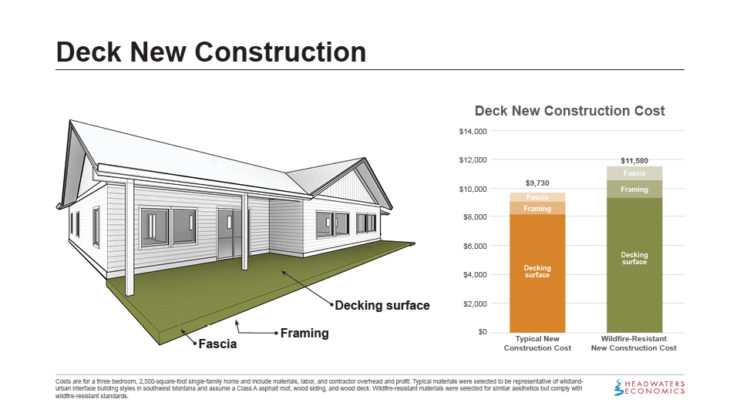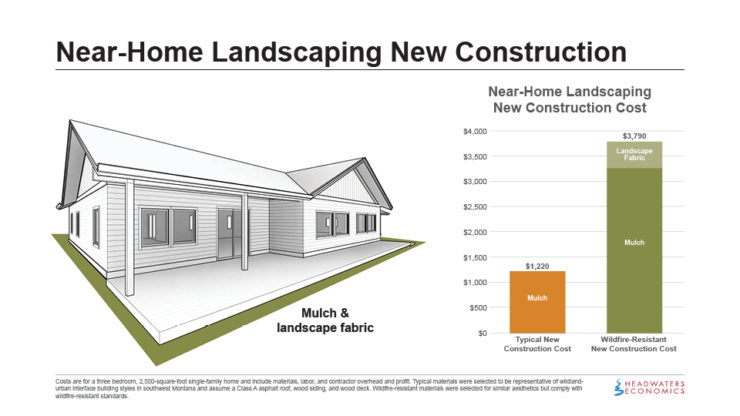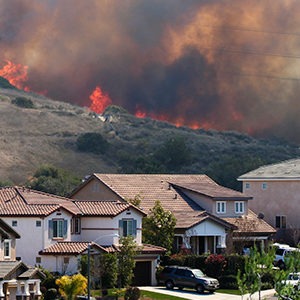- Wildfire disasters will be more common if unmitigated home development continues in the wildland-urban interface.
- A new home built to wildfire-resistant codes can be constructed for roughly the same cost as a typical home.
- Costs vary for retrofitting an existing home to be wildfire-resistant, with some components such as the roof and walls having significant expense. Some of these costs can be divided and prioritized into smaller projects.
- Technology and standards exist today that will make communities safer. Cities, counties, and other jurisdictions can implement wildfire-resistant building codes to reduce their vulnerability to wildfire.
Components of this research have been published in: Manzello S. (Eds.), Encyclopedia of Wildfires and Wildland-Urban Interface (WUI) Fires. New York: Springer.
Introduction
This study finds negligible cost differences between a typical home and a home constructed using wildfire-resistant materials and design features. Decades of research and post-fire assessments have provided clear evidence that building materials and design, coupled with landscaping on the property, are the most important factors influencing home survivability during a wildfire.
Today, one-third of all U.S. homes are in the wildland-urban interface, the area where flammable vegetation and homes meet or intermingle. And with more than 35,000 structures lost to wildfire in the last decade, more communities should consider adopting building codes that require new home construction to meet wildfire-resistant standards.
While codes and standards have been developed for building in wildfire-prone lands, the perceived cost of implementing such regulations is a commonly cited barrier to consideration and adoption by some communities. However, little research has previously examined how much it would actually cost the homeowner or builder to comply with such regulations.
For this research, a full report, an executive summary, and appendix (Excel) are available. The work was completed in partnership with The Insurance Institute for Business & Home Safety (IBHS) and Bechtle Architects and was prepared at the request of Park County, Montana, as part of the Community Planning Assistance for Wildfire (CPAW) program. CPAW is a program of Headwaters Economics and is funded by the U.S. Forest Service, the LOR Foundation, and other private foundations.
Subscribe to our newsletter!
Wildfire-Resistant Codes and Standards
While certain jurisdictional codes have been established, three existing statewide or national building codes and standards guide wildfire-resistant construction. They are:
• the International Code Council’s International Wildland Urban Interface Code (IWUIC),
• the National Fire Protection Association’s Standard for Reducing Structure Ignition Hazards from Wildland Fire (Standard 1144), and
• the California Building Code Chapter 7A—Materials and Construction Methods for Exterior Wildfire Exposure.
These three documents address construction requirements of the home by component parts (e.g., roof, walls, etc.) and often provide multiple options for complying with the provision. Many of the requirements in these documents are based on standard laboratory testing methods that evaluate the ability of a material or assembly to resist ignition or fire spread. California is one of only a few states to have adopted a wildfire-related building code at the state level for areas of high hazard, but many cities and counties have adopted portions of the IWUIC or other wildfire-related codes. In some communities, the inaccurately assumed cost of constructing a home to comply with a wildfire-resistant building code is a barrier to implementing such codes.
Wildfire-Resistant Construction Costs Are Similar to Typical Costs
To identify whether the cost of constructing to a wildfire-resistant building code differs from typical construction, this study priced new construction and retrofitting expenses for a three-bedroom, 2,500-square-foot, single-story, single-family home representative of wildland-urban interface building styles in southwest Montana, one of the fastest-growing regions in the country.
The typical home was assumed to have an asphalt shingle roof, wood siding, dual-pane windows, and a wood deck. Wildfire-resistant materials were selected for similar aesthetics but also comply with wildfire-resistant building codes. Costs were primarily derived from RSMeans, a database that averages material and labor pricing from hundreds of U.S. cities and includes materials, labor, and contractor overhead and profit.
We examined costs in four vulnerable components of the home: the roof (including gutters, vents, and eaves), exterior walls (including windows and doors), decks, and near-home landscaping. Overall, the wildfire-resistant construction cost 2% less than the typical construction, with the greatest cost savings resulting from using wildfire-resistant fiber cement siding on exterior walls, in lieu of typical cedar plank siding. While cedar plank siding is typical in the wildland-urban interface of western Montana, fiber cement siding is already a common choice in many regions because of its relative affordability, durability and low maintenance needs. Wildfire-resistant changes to the roof resulted in the largest cost increase, with a 27% increase in gutters, vents, and soffits. The following sections describe the wildfire-resistant mitigations for each component.
Roof
The roof is arguably the most vulnerable area of the home because of its large surface area. Embers can ignite vegetative debris that has accumulated on the roof surface or in gutters. Embers also can enter the attic through roof and under-eave vents. Also, unenclosed eaves and overhangs can trap embers and heat.
Wildfire-resistant modifications to roofing, vents, fascia, soffits, and gutters added $5,860 (27%) to the cost of the typical roof, assuming both homes use Class A (fire-rated) asphalt composition shingles. Retrofitting an existing roof to be wildfire-resistant approached the cost of new construction, totaling $22,010 for the model home. However, many of the wildfire-resistant roof materials have longer lifespan and reduced maintenance needs as compared to typical materials.
Exterior Walls
Exterior walls are especially vulnerable from exposure to flames or prolonged exposure to radiant heat, such as from burning vegetation or a neighboring home. These exposures can potentially ignite combustible siding products. Some plastic siding products (e.g., vinyl) can also melt, exposing underlying sheathing. Wind-blown embers can accumulate in gaps or pass through openings around windows and doors. Glass in a window or door can break from radiant heat or flame contact, exposing the interior of the home. Wildfire-resistant siding and installation design features, tempered glass in windows, wildfire-resistant doors, and weather-stripping can reduce home vulnerability. The relative importance of each of these items varies depending on home-to-home spacing and location of vegetation on the property. Siting on the property relative to topography and typical wind directions can also be important factors in determining necessary external wall mitigations.
Wildfire-resistant construction for exterior walls was $12,190 (25%) less expensive than the typical home, with the cost savings resulting from the difference in using wildfire-resistant fiber-cement siding as compared to cedar plank siding. Fiber cement siding is already a common siding option in many regions and several styles options mimic the look of wood siding. While the change in siding reduced the cost of the wildfire-resistant home, cost increases for other exterior wall features are $5,370 (29%) more than typical exterior wall features. Retrofitting the exterior walls (including windows and doors) on the model home totaled $40,750. Depending on neighboring home spacing, not all retrofitting activities may be necessary, but several of these activities will have added benefits such as improved energy efficiency (e.g., multi-pane windows) and reduced maintenance.
Deck
Embers can ignite vegetative debris or other combustible material stored or accumulated on top of the deck. If ignited, the burning deck could expose walls, windows, and doors to radiant heat. Embers can ignite decking materials directly when they accumulate on the surface of vulnerable decking, typically occurring in the gaps between deck boards. Decks can also ignite from below when vegetation or stored materials ignite beneath the deck. Mitigations to make a deck wildfire-resistant include using wildfire-resistant materials for walking surface (e.g., composite boards), using foil-faced bitumen tape on the top surface of the support joists, and creating a noncombustible zone underneath the deck. The wildfire-resistant deck added $1,850 (19%) to the cost of the typical deck. Some wildfire-resistant decking materials can have a longer lifespan and require less maintenance than typical materials.
Near-Home Landscaping
If ignited by wind-blown embers, burning vegetation and other combustible materials near the home can allow flames to touch the home or subject it to an extended radiant heat exposure, potentially igniting siding or breaking glass in windows. Maintaining a noncombustible zone of five feet around the entire perimeter of the house and outer edges of the deck can significantly reduce the vulnerability of the home. Mitigations include using rock instead of bark mulch on top of landscape fabric. Placing landscape fabric underneath the area can reduce the growth of weeds, thereby minimizing the maintenance needed by the homeowner. These modifications increased the cost of near-home landscaping by $2,570 (210%). Rock has a longer lifespan than bark mulch and landscape fabric will reduce the maintenance required in the near-home landscaping area.
Costs Should Not Be a Barrier to Constructing Wildfire-Resistant Homes
Laboratory research and post-fire analysis have determined that local ignitability of the home itself, largely determined by the building materials and design features, is an important factor in determining survivability during a wildfire. Existing codes and standards provide ample guidance for how to construct a wildfire-resistant home and reduce vulnerability. This study demonstrates that a new home can be constructed to such standards for approximately the same cost as a typical home, and some of these materials have added benefits such as longer lifespan and reduced maintenance.
City, county, and state governments must weigh many issues when considering new regulations, but the cost of constructing a home to meet wildfire-resistant building codes need not be a barrier. If communities continue to allow growth in wildfire-prone lands, adopting wildfire-resistant building codes may be one of the most effective tools for reducing home loss. Absent such requirements, homeowners and builders can take steps to protect the home by carefully designing and constructing (or retrofitting) the most vulnerable components—the roof, walls, deck, and landscaping—to be wildfire-resistant. The long-term benefits may include longer lifecycle and reduced maintenance.
As recent wildfire disasters have demonstrated, the converging trends of rapid growth in the wildland-urban interface, fuel accumulation after a century of fire suppression, and a warming climate will make wildfires more costly and dangerous in years to come. Just as the cause of this problem is multipronged, there is no single solution to protecting lives and property and we must employ a suite of solutions that include land use planning, vegetation management, and emergency preparedness. Constructing homes to be wildfire-resistant is a critical and cost-effective piece of the puzzle.
In addition to the full report, you can also download:
